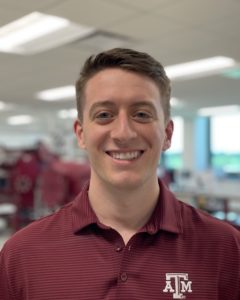Ph.D. Student (Graduated Spring 2024), J. Mike Walker ’66 Department of Mechanical Engineering
Graduate Research Fellow, National Science Foundation (NSF)
Graduate Ambassador, TAMU MEEN Department
Fully Trained 2SLGG Gunner

103A Doherty Building, 3123 TAMU, College Station, TX 77843
Hometown: Lucedale, MS
Email: jacob_rogers@tamu.edu
CV/Resume: Jacob_Rogers.pdf
Jacob was a Ph.D. student in the Texas A&M University (TAMU) J. Mike Walker ’66 Department of Mechanical Engineering with a background in solid mechanics, hypervelocity impact damage mechanics, and aeroballistic range testing. Upon admission to TAMU and under the guidance of co-advisors Dr. Thomas Lacy and Dr. Justin Wilkerson, Jacob received a graduate research assistant (GAR) position and was also awarded a Mechanical Engineering Graduate Merit Fellowship. During spring of 2020, Jacob was awarded the J. Mike Walker ’66 Department of Mechanical 2020 Graduate Summer Research Grant for his research on novel protective structure concepts. His research at TAMU on novel, tailored polymeric materials and structures to mitigate hypervelocity impact (HVI) threats enabled him to receive the National Science Foundation (NSF) fellowship. Jacob was instrumental in establishing the TAMU Hypervelocity Impact Laboratory (HVIL) in January 2020. At the HVIL, he currently studies HVI (2.5-8.0 km/s) phenomena and materials for extreme environments. Over the short time since HVIL’s launch, Jacob and the HVIL team have performed over 600 HVI experiments and made numerous advancements in diagnostics, experimental capabilities, and two-stage light gas gun (2SLGG) operational efficiency. His research interests also include computational solid mechanics, hypersonics, ultra-high strain-rate materials, and micrometeoroid/orbital debris (MMOD) impacts. He completed his undergraduate degree in Aerospace Engineering at Mississippi State University (MSU) in May of 2019. While at MSU, he was named a Stephen D. Lee Scholar and awarded Aerospace Engineering Student of the Year (2019), multiple first-place research symposium awards, and two undergraduate research fellowships. He researched HVIs and conducted full-scale 2SLGG experiments under the guidance of Dr. Lacy for much of his undergraduate career. He has supplemented his time spent on research with time dedicated to mentorship and leadership, mentoring multiple undergraduate design teams. He served as president of MEGSO (2022-2023) and is a member of ASME, AIAA, and International Ballistics Society (IBS), as well as the Tau Beta Pi, Phi Kappa Phi, Sigma Gamma Tau, and Sigma Xi academic honor societies. Jacob plans to use his experience at TAMU studying HVI phenomena to advance the scientific knowledge of HVI physics and to develop cutting-edge protective structures that will better protect against emerging space and military threats.
